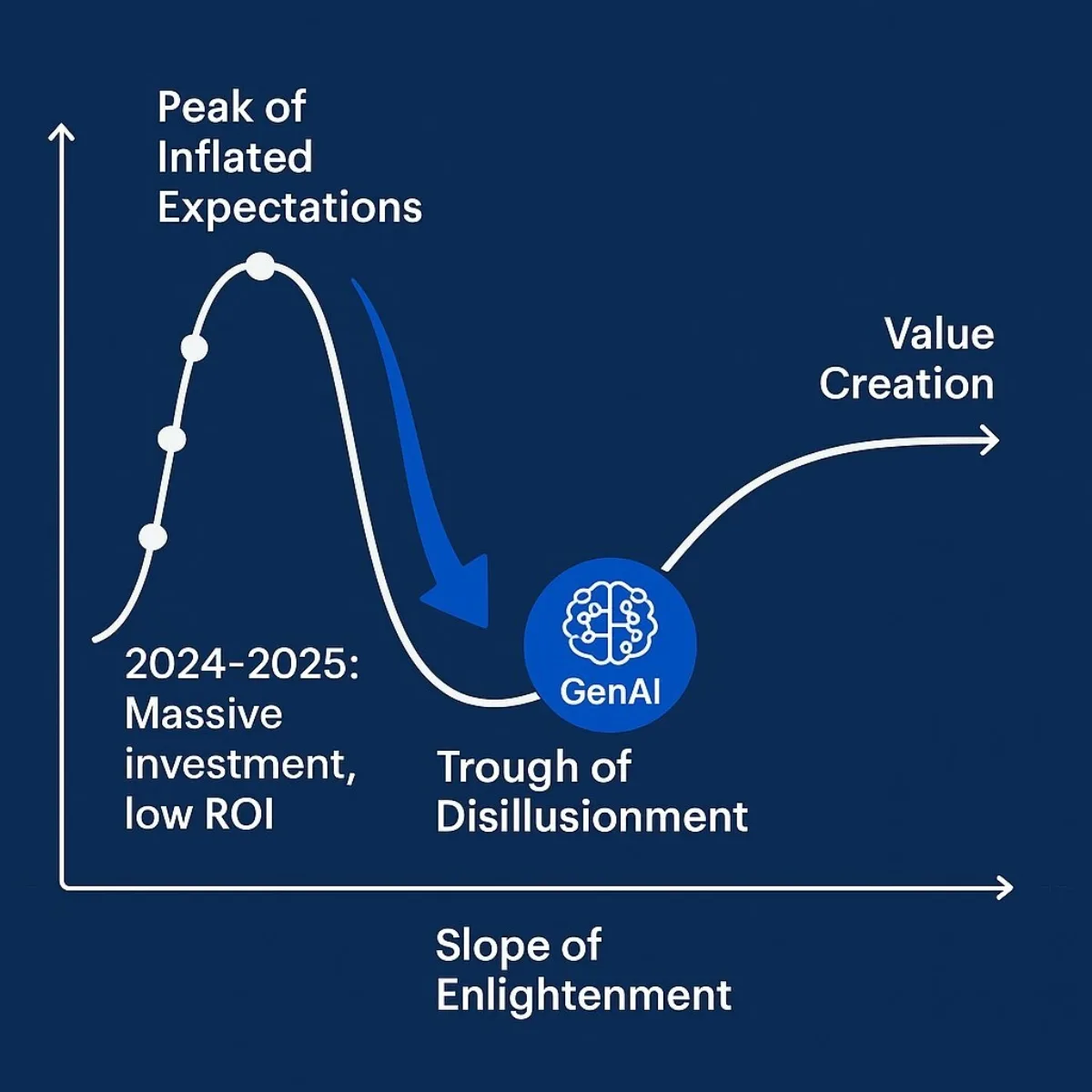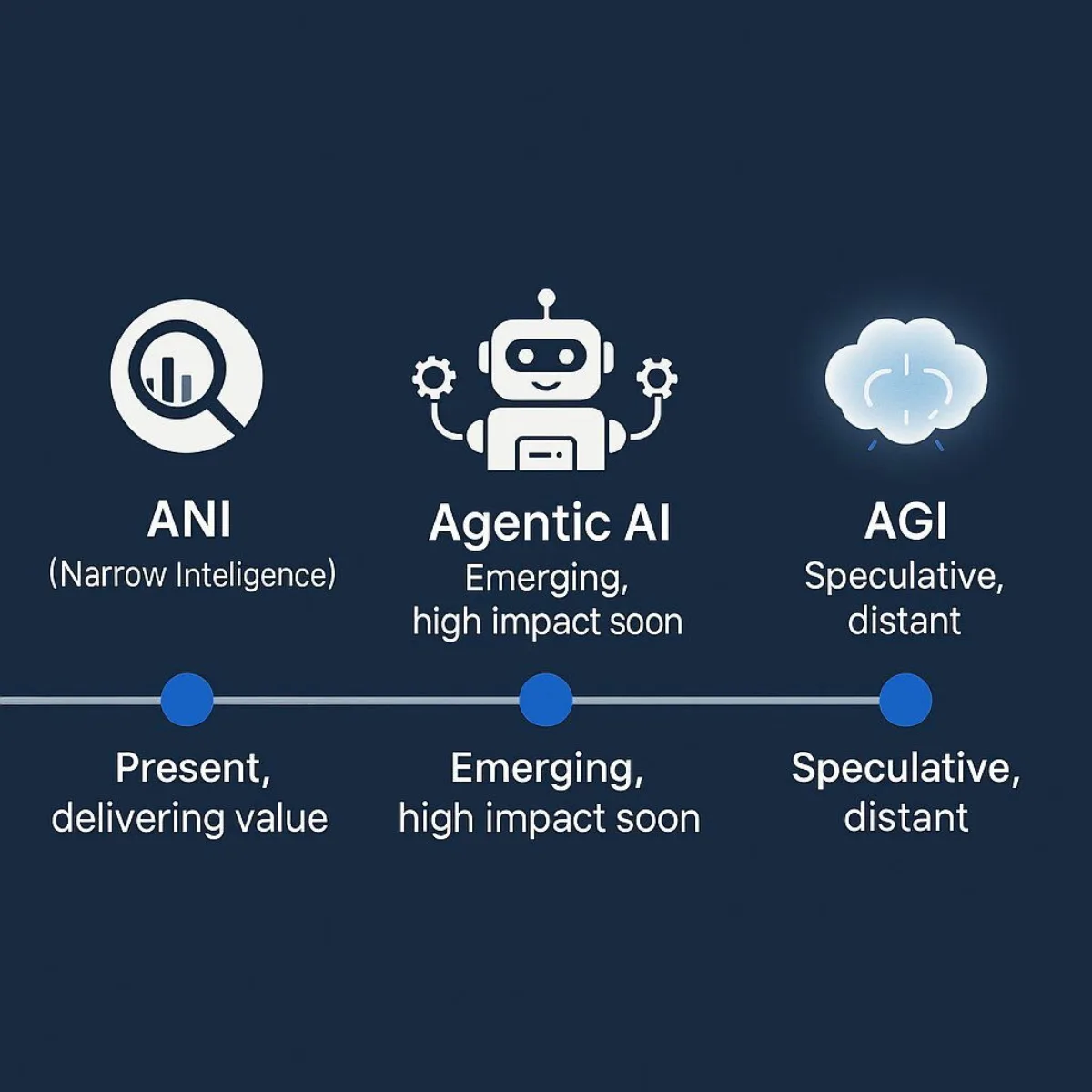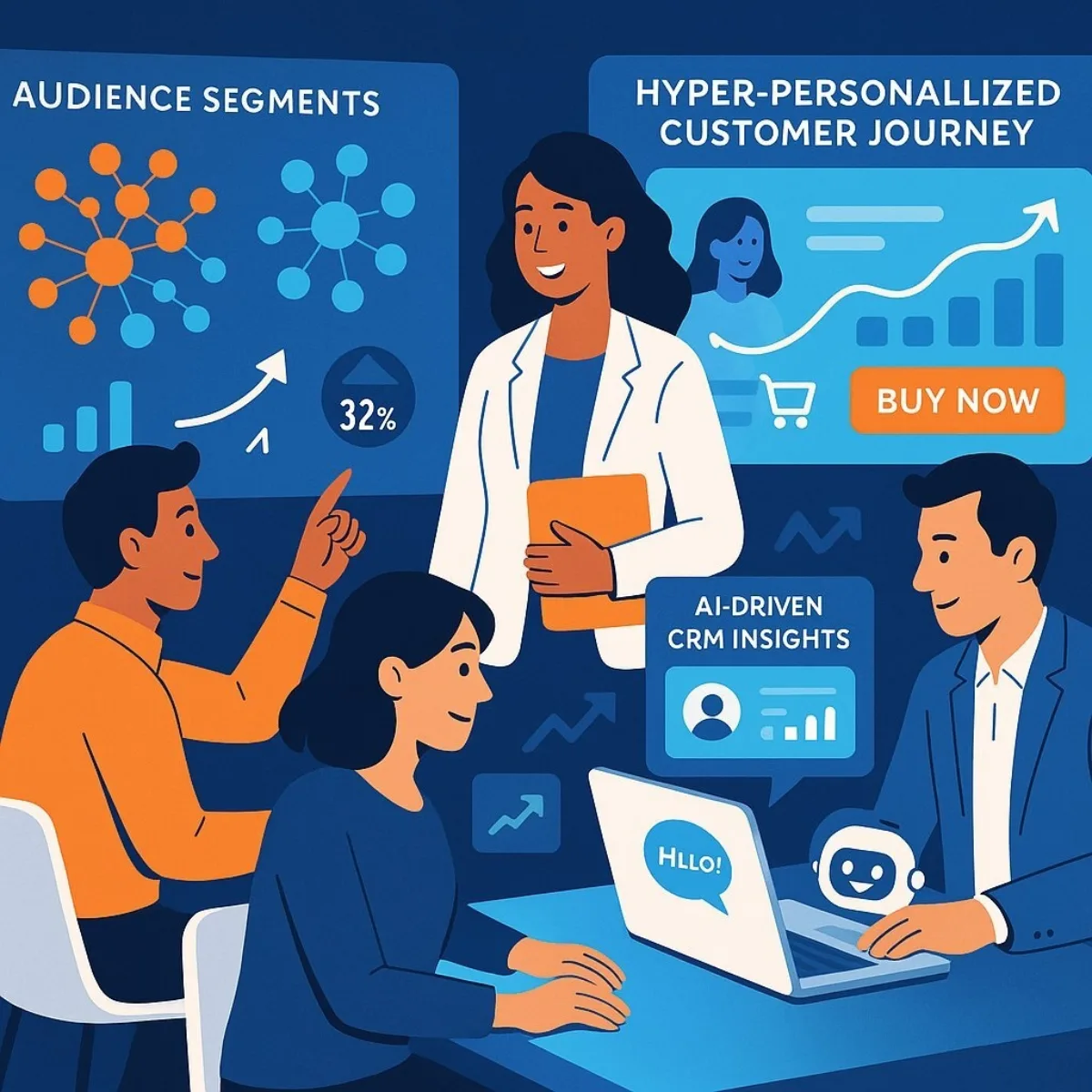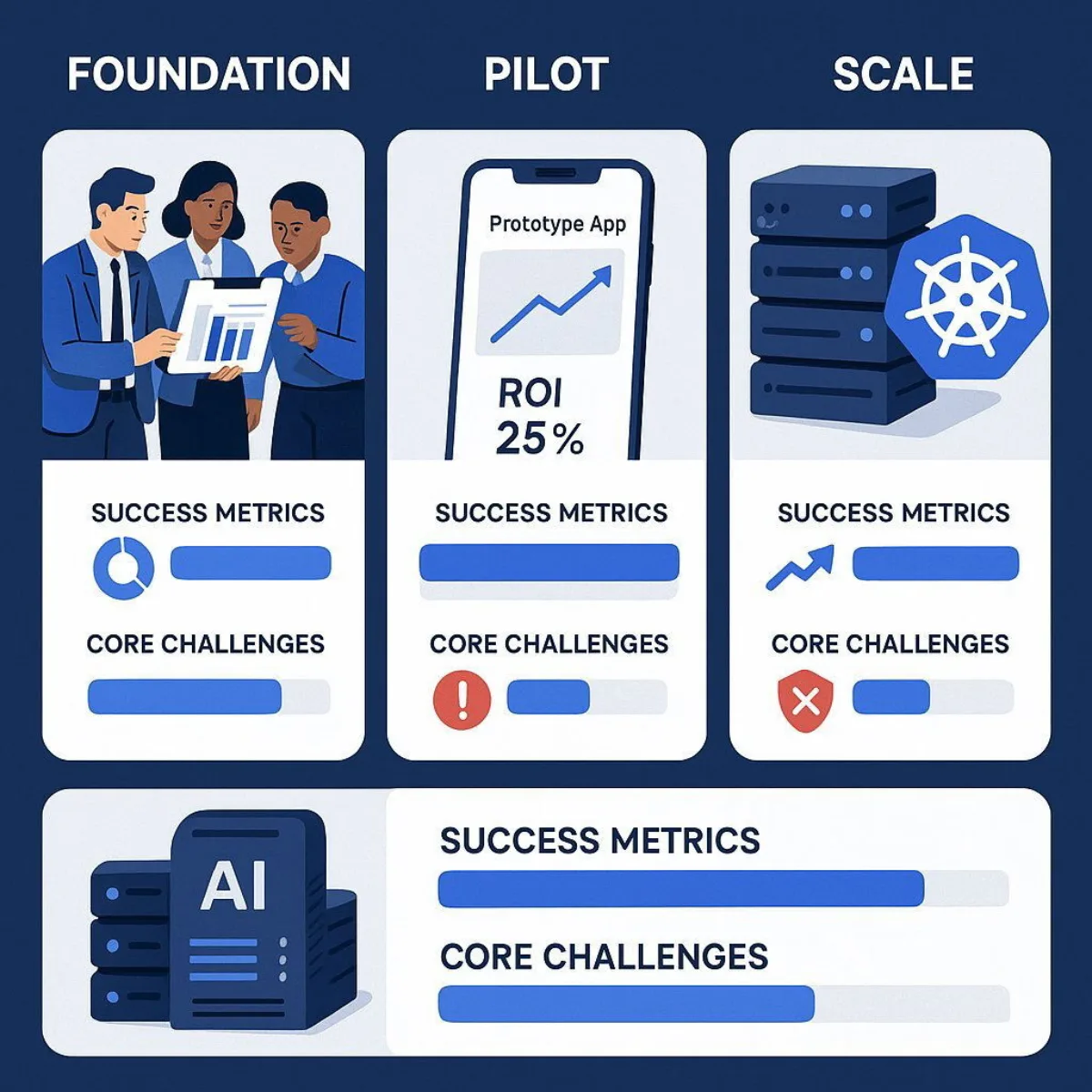
Moving Beyond AGI Hype: How Businesses Can Unlock Real AI Value Today
September 07, 2025 / Bryan ReynoldsThe AGI Hype Is Fading. For Businesses, That’s a Good Thing.
You’ve seen the headlines. Tech stocks are sliding, prominent CEOs are admitting to an investor "bubble," and a healthy dose of skepticism is finally tempering the feverish hype around Artificial General Intelligence (AGI). For business leaders who have been navigating the relentless noise, a critical question emerges: What does this tech industry retreat from AGI hype actually mean for business?
The answer is simple: this is not the dawn of an "AI winter." It is a crucial and profoundly beneficial market correction. The retreat from AGI marks a pivot from speculative, science-fiction-inspired promises to a pragmatic focus on tangible, measurable business value. This shift is an opportunity for leaders to stop chasing the ghost of a conscious machine and start building real, defensible competitive advantages with the powerful AI that works today. The end of the hype cycle doesn't close the door on AI; it opens the door for smart, strategic implementation.
The Great AGI Hangover: Why the Market Is Pumping the Brakes
The current market cooldown is not a reaction to a fundamental failure of AI technology, but rather the inevitable consequence of a narrative that outpaced reality. For months, the promise of AGI—a hypothetical AI with human-level cognitive abilities—justified astronomical valuations and massive R&D expenditures, even as the immediate return on investment for generative AI (GenAI) remained elusive. Now, the bill is coming due, and investors are demanding results, not rhetoric.
The Sobering Reality of AI ROI
The data paints a stark picture of the gap between expectation and execution. A landmark 2025 report from MIT, The GenAI Divide, revealed that a staggering 95% of business attempts to integrate generative AI are failing to produce meaningful results. Only 5% of companies have managed to achieve "rapid revenue acceleration" from their pilot programs. This finding is a critical anchor for the current market sentiment, explaining why the initial euphoria has given way to caution.
This disillusionment is formally recognized by leading industry analysts. The 2025 Gartner Hype Cycle officially places Generative AI in the “Trough of Disillusionment.” This stage signifies that the initial inflated expectations have crashed against the hard wall of implementation challenges, governance issues, and a struggle to prove value. The data shows that despite an average spend of $1.9 million on GenAI initiatives in 2024, less than 30% of AI leaders report that their CEOs are happy with the return on investment.
The narrative is further grounded by voices from within the industry and academia. OpenAI CEO Sam Altman himself described the current AI market as a "bubble" filled with "overexcited investors". Meanwhile, economists like MIT's Daron Acemoglu project that AI will expand the US economy by a modest 1% over the next decade—a valuable contribution, but hardly the world-altering revolution that was promised.

The AGI Definition Dilemma
A core reason AGI became such a convenient vehicle for hype is its lack of a clear, stable definition. It is an ill-defined, moving target that allows proponents to claim progress without meeting concrete benchmarks. Definitions from industry leaders vary wildly and are often contradictory. Anthropic CEO Dario Amodei defined AGI as being "smarter than a Nobel Prize winner across most relevant fields," while Microsoft AI CEO Mustafa Suleyman offered a more functional, if abstract, definition: any system that can turn $100,000 into $1,000,000.
This ambiguity creates a strategic vacuum for businesses. AI expert Melanie Mitchell, a professor at the Santa Fe Institute, has voiced concerns that without a universally agreed-upon definition, tech companies might simply "redefine AGI into existence" to declare victory without achieving a true technological breakthrough. For business leaders, it is impossible to build a coherent, long-term strategy around a goal that has no stable definition or measurable endpoint.
The following table summarizes the stark contrast between the promises of the AGI hype cycle and the practical realities facing enterprises today.
| The AGI Promise (The Hype) | The Enterprise Reality (The Hangover) |
|---|---|
| Human-level intelligence that can solve any problem. | 95% of GenAI pilots fail to deliver meaningful revenue. |
| Trillions in economic value and massive productivity boosts. | GenAI is in the "Trough of Disillusionment" ; CEOs are unhappy with ROI. |
| AGI is "just a few years away," according to some tech CEOs. | Most AI researchers believe AGI is not imminent and is always "10 years away". |
| An autonomous digital workforce that replaces human jobs. | AI agents complete only 24% of real-world jobs ; human verification is a major bottleneck. |
| A clear, inevitable technological destination. | An ill-defined, contested concept with no agreed-upon benchmark for success. |
Forget AGI. Focus on the AI That Actually Works.
To move forward, business leaders need a clear, pragmatic framework for understanding the AI landscape. The key is to shift focus from the speculative future to the high-value technologies available now. This means cutting through the alphabet soup of AI terminology and concentrating on the categories that have direct business relevance today.
Demystifying the AI Alphabet Soup: ANI, Agentic AI, and AGI
For strategic planning purposes, the vast field of AI can be simplified into three distinct categories, each with a different level of maturity and business applicability.
- Artificial Narrow Intelligence (ANI): This is the workhorse AI that exists today and powers virtually every AI application in production. ANI, also known as Weak AI, is designed to perform a specific, narrow task with superhuman efficiency and accuracy. Examples include the algorithms used for fraud detection in finance, diagnostic image analysis in healthcare, and programmatic ad targeting in marketing. One hundred percent of the current business value generated by AI comes from ANI systems.
- Agentic AI: This is the next major frontier and the most significant near-term opportunity for enterprises. Agentic AI is an evolution of ANI where AI systems can autonomously plan, orchestrate tools, and execute multi-step tasks to achieve a specific goal. It is not AGI. Forrester provides a clear, functional definition: "software that can autonomously act in pursuit of goals across domains by learning new skills, collaborating with humans and machines, and building software tools". This is the critical bridge between today's content-generating chatbots and tomorrow's true process automation.
- Artificial General Intelligence (AGI): This remains the long-term, hypothetical research goal of creating a machine with the generalized cognitive abilities of a human. While a fascinating scientific pursuit, it is a distraction from current business strategy and should not be a factor in near-term technology roadmaps.
The emergence of "Agentic AI" as a key industry focus is a direct response to the limitations of earlier "Generative AI" models. While GenAI proved adept at generating content like text and images, it was less effective at doing things that directly drive business processes and outcomes. Agentic AI shifts the focus from content creation to action and workflow automation, which is where the most significant enterprise ROI is found. This transition elevates the strategic importance of building robust, secure, and deeply integrated systems where AI agents can interact with core enterprise software—a complex engineering challenge that goes far beyond simple prompt engineering.
The AI Maturity Spectrum for Business
The following chart maps these AI categories onto a strategic timeline, providing a clear visual roadmap for business leaders to prioritize investment and effort.

This framework helps shift the conversation from "When will AGI arrive?" to "How do we master ANI today and prepare for the high-impact arrival of Agentic AI tomorrow?"
The Real ROI: Where Practical AI Is Delivering Value in 2025
The most effective way to understand the power of practical AI is to see how it solves real-world business problems for specific roles. Instead of abstract capabilities, the focus should be on tangible outcomes that drive efficiency, growth, and innovation.
For the Strategic CFO: Driving Efficiency and De-Risking the Enterprise
For finance leaders, the primary value of AI lies in its ability to automate complex processes, reduce costs, and provide predictive insights that strengthen financial governance.
- Dynamic Budgeting and Forecasting: AI is transforming the static annual or quarterly budget into a dynamic, continuous process. AI models can adjust forecasts in real-time based on live data inputs like market trends, supply chain disruptions, and sales fluctuations, enabling more agile financial planning.
- Automated Fraud Detection and Prevention: Machine learning algorithms can analyze millions of transactions in real-time to identify anomalous patterns that signal potential fraud. This allows finance teams to move from reactive investigation to proactive prevention, mitigating risks before significant financial damage occurs.
- Intelligent Accounts Payable/Receivable: AI can automate the entire lifecycle of invoice processing, from data extraction and validation to payment matching and collections. This dramatically improves cash flow, reduces manual overhead, and minimizes human error.
- Enhanced Credit Risk Assessment: By integrating a wider array of real-time data—from market signals to alternative data points like payment histories—AI models provide a more accurate and dynamic assessment of creditworthiness, enabling more informed lending decisions and reducing exposure to bad debt.
For the Growth-Focused Sales & Marketing Leaders: Hyper-Personalization at Scale
For sales and marketing executives, AI is the key to unlocking unprecedented levels of personalization and efficiency, turning mass marketing into a series of one-to-one conversations.
- Intelligent Audience Segmentation and Targeting: AI can analyze vast customer datasets to identify nuanced, high-value audience segments. This allows for hyper-targeted programmatic advertising campaigns that significantly improve ad spend ROI by reaching the right customer with the right message at the right time.
- Personalized Customer Journeys: AI-driven personalization engines can deliver tailored content, product recommendations, and offers to individual users in real-time across websites and apps. This creates a more engaging customer experience that boosts conversion rates and loyalty.
- Automated Content Generation and Optimization: Generative AI can be used to create drafts of marketing copy, email campaigns, social media posts, and blog articles. This frees up creative teams to focus on high-level strategy and brand development while ensuring a consistent stream of content.
- AI-Powered CRM and Sales Enablement: AI can automate routine tasks within CRM systems, such as data entry and activity logging. More advanced applications can analyze customer interactions to identify at-risk accounts, forecast sales with greater accuracy, and provide sales teams with intelligent talking points and next-best-action recommendations.

For the Visionary CTO: Building an Intelligent, Automated Foundation
For technology leaders, practical AI is not just another application to deploy; it is a fundamental component of a modern, intelligent, and automated enterprise architecture.
- Industry-Specific Transformation (Healthcare Example): In healthcare, practical AI is making a life-saving impact. AI-powered diagnostic tools are assisting radiologists in detecting conditions like lung nodules and breast cancer with significantly higher accuracy than human review alone. Simultaneously, AI-driven automation of administrative tasks like clinical notetaking is reducing physician burnout and saving hundreds of billions in operational costs.
- Accelerating the Software Development Lifecycle (AI in DevOps): A modern DevOps culture is essential for deploying AI effectively. AI tools are now being integrated directly into the software development lifecycle to automate testing, monitor CI/CD pipelines for anomalies, predict potential system outages, and even suggest and review code. This accelerates development velocity and improves software quality. Building these intelligent pipelines requires expertise in platforms like Azure DevOps On-Prem and tools like VS Code/VS 2022, integrating them into a seamless workflow. Learn more about DevOps efficiency for modern enterprises.
- Building Scalable AI/ML Infrastructure: AI workloads are resource-intensive, often requiring specialized hardware like GPUs. Managing this infrastructure efficiently is a major challenge. This is where containerization (Docker) and orchestration platforms like Kubernetes become critical. Kubernetes allows teams to manage, scale, and deploy AI applications consistently across any environment, from on-premise servers (Harvester HCI) to public clouds (OVHCloud). Platforms like Rancher provide a unified management layer for these complex environments, ensuring that expensive computational resources are used optimally and that AI applications are both resilient and scalable. Discover strategies for scaling Kubernetes in the enterprise for robust AI deployments.
Your Strategic Roadmap: Building a Foundation for Practical AI Wins
The retreat from AGI hype clarifies the strategic imperative for business leaders: focus on building sustainable, value-driven AI capabilities. This requires a deliberate approach that addresses the core challenges of implementation and makes a critical choice between generic and tailored solutions.
The "Build vs. Buy" Dilemma in the Post-Hype Era
The high failure rate of AI pilots underscores a fundamental flaw in the "buy" or off-the-shelf approach for core business challenges.
- Limitations of Off-the-Shelf AI: Generic, pre-packaged AI tools promise quick deployment but often fall short. They are difficult to integrate with legacy enterprise systems, lack the flexibility to adapt to unique business workflows, and, most importantly, cannot be trained on a company's most valuable and differentiating asset: its proprietary data. This mismatch is a primary reason why many AI projects stall in the pilot phase and never deliver scalable value.
- The Advantage of Custom AI: In contrast, custom-built AI solutions, while requiring a greater upfront investment, are engineered to solve specific business problems. They are designed for seamless integration with existing infrastructure and are trained on an organization's unique datasets. This tailored approach leads to superior performance, a durable competitive advantage, and a significantly higher long-term return on investment. It allows a business to build an asset that is uniquely its own, rather than renting a generic capability from a vendor. See why custom software is now the competitive edge for enterprises.
Overcoming the Top 3 Enterprise AI Roadblocks
Successfully implementing custom AI requires overcoming three common, well-documented challenges.
- Data Quality and Governance: Poor data quality is the single most significant barrier to AI success. The most effective strategy is not to wait for a perfect, enterprise-wide data lake. Instead, businesses should launch a high-value pilot project that forces the organization to establish rigorous data governance, cleaning, and management processes for a single, well-defined use case. This creates a repeatable model for future initiatives. Get insights from the AI governance and strategic asset management framework.
- Integration with Legacy Systems: AI solutions that cannot connect to core business systems like ERPs and CRMs are destined to fail. Many legacy systems lack the modern APIs required for seamless integration. The solution is a rapid, agile development approach that prioritizes building a robust API layer to connect the AI models to the systems where the business actually runs. This requires a partner with deep expertise in both software engineering and adaptive, agile deployment methodologies—see our approach to agile software development.
- Infrastructure and Scalability: AI is not just another piece of software; it is a demanding computational workload. A scalable, flexible, and cost-effective infrastructure is non-negotiable. As mentioned, this is where a modern tech stack built on containerization (Docker) and orchestration (Kubernetes) is essential. These technologies, managed through platforms like Rancher on reliable infrastructure such as OVHCloud servers, provide the foundation needed to move AI projects from a data scientist's laptop to a resilient, enterprise-grade production environment.
A Practical AI Implementation Framework
For executives ready to move forward, the following table provides a phased, actionable roadmap for turning AI ambition into tangible business results.
| Phase | Key Actions | Success Metrics | Key Challenge to Overcome |
|---|---|---|---|
| Phase 1: Foundation (Months 1-3) | Identify 1-2 high-impact business problems. Audit data readiness for those specific use cases. Establish a cross-functional AI governance team. | A prioritized list of AI projects with clear business cases. A data quality report and remediation plan. A documented governance charter. | Gaining stakeholder alignment and moving beyond "AI for AI's sake". |
| Phase 2: Pilot (Months 4-9) | Develop a custom AI pilot for the top-priority use case. Integrate with one or two key systems. Measure performance against baseline metrics. | A functional prototype. Measurable improvement in a key KPI (e.g., 10% reduction in fraud, 15% increase in lead conversion). A clear ROI projection. | Proving value quickly to justify further investment and avoiding "pilot purgatory". |
| Phase 3: Scale (Months 10-18+) | Refine the pilot model and scale it across the relevant department. Build out robust MLOps infrastructure (leveraging Kubernetes). Begin developing the next high-priority use case. | Full production deployment of the first AI solution. Documented cost savings or revenue gains. A repeatable playbook for future AI projects. | Managing technical debt, ensuring model reliability, and scaling infrastructure efficiently. |

Conclusion: Your Next Move in the Age of Practical AI
The tech industry's retreat from AGI hype is not a signal to pull back on AI. It is a call to get real. It means businesses can finally stop speculating and start executing. It means shifting investment from vague, long-term promises to specific, value-driven AI solutions that solve today's most pressing problems. In this new, more pragmatic era, the competitive advantage will go not to the biggest dreamer, but to the most disciplined and effective implementer.
Actionable Next Steps
- Reframe the AI Strategy: Shift the focus of the internal AI steering committee from a broad mandate of "exploring GenAI" to a specific mission of "solving business problem X with a targeted AI solution." Always start with the business problem, not the technology.
- Launch a Small, High-Impact Pilot: Instead of a sprawling, undefined AI initiative, fund a single, focused 6-month custom AI project aimed at moving a clear metric in finance, sales, or operations. Use this pilot as a vehicle to gain hands-on experience with the organization's unique data, integration, and governance challenges—see how to get started and integrate AI in your B2B firm.
- Assess the "Build" Capability: Conduct an honest evaluation of whether the organization has the in-house talent, infrastructure, and agile processes required to build, deploy, and manage enterprise-grade AI applications. If gaps exist, begin the conversation with a specialist partner who possesses deep expertise in both custom software engineering and modern AI infrastructure.
The age of AI hype is over. The age of practical AI has begun. For leaders ready to move beyond the noise and build a pragmatic roadmap, the opportunity to create real, lasting value is immense.
Further Reading
- https://www.forrester.com/report/the-quiet-roar-of-artificial-general-intelligence/RES185653
- https://www.mckinsey.com/capabilities/quantumblack/our-insights/the-state-of-ai
- https://economictimes.indiatimes.com/magazines/panache/mit-study-shatters-ai-hype-95-of-generative-ai-projects-are-failing-sparking-tech-bubble-jitters/articleshow/123428252.cms
About Baytech
At Baytech Consulting, we specialize in guiding businesses through this process, helping you build scalable, efficient, and high-performing software that evolves with your needs. Our MVP first approach helps our clients minimize upfront costs and maximize ROI. Ready to take the next step in your software development journey? Contact us today to learn how we can help you achieve your goals with a phased development approach.
About the Author

Bryan Reynolds is an accomplished technology executive with more than 25 years of experience leading innovation in the software industry. As the CEO and founder of Baytech Consulting, he has built a reputation for delivering custom software solutions that help businesses streamline operations, enhance customer experiences, and drive growth.
Bryan’s expertise spans custom software development, cloud infrastructure, artificial intelligence, and strategic business consulting, making him a trusted advisor and thought leader across a wide range of industries.


